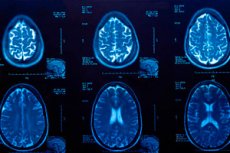Nye publikasjoner
Forskere anbefaler hjerneskanning av spedbarn for å redusere risikoen for hjerneslag
Sist anmeldt: 02.07.2025

Alt iLive-innhold blir gjennomgått med medisin eller faktisk kontrollert for å sikre så mye faktuell nøyaktighet som mulig.
Vi har strenge retningslinjer for innkjøp og kun kobling til anerkjente medieområder, akademiske forskningsinstitusjoner og, når det er mulig, medisinsk peer-evaluerte studier. Merk at tallene i parenteser ([1], [2], etc.) er klikkbare koblinger til disse studiene.
Hvis du føler at noe av innholdet vårt er unøyaktig, utdatert eller ellers tvilsomt, velg det og trykk Ctrl + Enter.

Ikke-invasive hjerneskanninger for barn under ett år kan identifisere risikofaktorer og redusere sjansen for hjerneslag senere i livet, ifølge forskere fra University of South Australia.
I en banebrytende studie har forskere funnet ut at til tross for forbedringer innen medisin, forblir mønstre av hjerneaneurismer stabile over tid, noe som betyr at variasjoner i hjernekar lett kan oppdages tidlig i livet.
Studien, som ble publisert i BMJ Open, analyserte 260 år med data for systematisk å vurdere langsiktige trender i hjerneaneurismer, som kan forårsake hjerneslag.
Globalt er hjerneslag den nest hyppigste dødsårsaken. Hvert år rammes 15 millioner mennesker over hele verden av hjerneslag. Av disse dør 5 millioner, og ytterligere 5 millioner blir varig uføre, noe som legger en betydelig byrde på familier, lokalsamfunn og økonomier.
I Australia viser statistikk at hjerneslag dreper flere kvinner enn brystkreft og flere menn enn prostatakreft. Blant den australske befolkningen forekommer et hjerneslag hvert 19. minutt.
Mer enn 80 % av alle slag kan forebygges. Med en anslått kostnad på rundt 300 000 dollar for et enkelt slag i Australia, er det ikke bare nøkkelen til forebygging å identifisere tidlige varseltegn, men det kan også spare millioner.
Ledende forsker og nevroanatomi-ekspert Dr. Arjun Burlakoti, førsteamanuensis i anatomi og nevroanatomi ved UniSA, sier at det å identifisere variasjoner i hjernekar hos barn kan forhindre hjerneslag senere i livet.
«En hjerneaneurisme er en utbuling av en arterie inn i hjernen. Det er forårsaket av en svakhet i arterieveggen. Hvis en hjerneaneurisme brister, kan det forårsake et hjerneslag», sier Dr. Burlakoti.
"Hjerneaneurismer kan utvikles i alle aldre. Selv om den vanligste alderen for diagnose er mellom 31 og 60 år, er forekomsten av hjerneaneurismer hos barn nesten lik den hos voksne. Forekomsten av aneurismer hos barn kan være sammenlignbar med den hos voksne fordi barndommen er en mye kortere levetid enn voksenlivet."
«Studien vår viser at aneurismer dannes og brister av sine egne iboende årsaker, og at eventuelle variasjoner i hjernekarene sannsynligvis vil være tilstede fra fødselen av.»
«Dette betyr at hvis vi kan identifisere variasjoner i hjernens arterielle nettverk i barndommen, kan vi mer aktivt overvåke og teste risikoutsatte individer gjennom hele livet.»
Forskere anbefaler å bruke ikke-invasiv transkraniell Doppler-ultralyd for å skanne spedbarn og barn for variasjoner i hjernekar. Denne smertefrie testen bruker lydbølger for å studere blodstrømmen i og rundt hjernen og oppdage variasjoner i blodkar.
De hevder at screeningmetoden kan muliggjøre rettidig intervensjon og potensielt forhindre aneurismer og hjerneslagrelaterte komplikasjoner.
«Screening for variasjoner i arterielle komponent hos barn, spesielt under 2 år, kan være et praktisk verktøy for å identifisere variasjoner i hjernearteriene», sier dr. Burlakoti.
«Dette er en trygg, ikke-invasiv screeningtest som gir familier en vei til regelmessig overvåking dersom det oppdages variasjoner.»
"Hvis du kan redusere risikoen din med en enkel screeningtest, hvorfor ikke gjøre det?"
